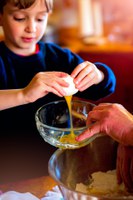Prairie Fare: Handle Flour Safely When Baking at Home
(Click an image below to view a high-resolution image that can be downloaded)
By Julie Garden-Robinson, Food and Nutrition Specialist
NDSU Extension
Do you remember the shortages we experienced in 2020?
Yes, toilet paper was in short supply in some areas.
In some places, grocery shoppers noted limited supplies of meat and milk.
Bakers were disappointed when yeast and flour were among the foods difficult to find in some stores.
Fortunately, these essential ingredients are available in 2021, just in time for fun summer learning at home.
Preparing food with kids has benefits that go beyond the foods that are made. Preparing food promotes reviewing school lessons and learning life skills in the process.
Whether preparing food with a parent, grandparent, sibling or caregiver, children can glean a lot of information.
Cooking and baking can combine science with artistic skills. We eat with our eyes before taking the first bite, so making food look good is part of the process of preparing and serving food.
Children learn basic chemistry skills when baking soda is combined in a recipe with acidic ingredients.
How about some math review? Kids learn about fractions when measuring accurately and multiplication if they are halving or doubling a recipe.
Baking also requires problem-solving skills when the temperature and the humidity of the day necessitate some changes in your breadmaking lessons.
Reading and following recipes strengthens reading and vocabulary skills. What does whisking, folding or kneading ingredients mean?
Food preparation requires planning. After you choose a recipe, you need to check your ingredient supply and shop for the missing items in your pantry or refrigerator.
Food preparation also requires patience, especially if yeast bread is involved.
With siblings working together, negotiation and conflict resolution skills may be practiced.
Children also learn about safety skills, from using knives to using an oven and appliances.
Most people know that cooking requires close attention to food safety, but baking also has some fairly recent cautions.
Be cautious where you get your baking recipes. Some recipe creators and users may not be aware of some of the more recent rules about handling raw flour.
For example, a quick search of popular recipe sites showed recipes targeting children at home. Several “doughs” were not baked and, therefore, are not considered safe.
Remember that when grain is milled into flour, it is not heated. Flour technically is a “raw” food and it should be heated prior to eating.
According to the Food and Drug Administration (FDA), several outbreaks of foodborne illness linked to E. coli and salmonella bacteria sickened 168 people and led to 20 hospitalizations. The products involved included cookie dough and cake mix. These were eaten raw or were undercooked. If they are baked properly, they are safe.
Keep these tips from the FDA in mind during summer food preparation involving flour:
- Follow the package directions when using baking mixes.
- Keep all raw foods such as flour and eggs separate from ready-to-eat foods.
- Refrigerate cookie and pastry dough according to package directions. Be sure your refrigerator is set at 40 F or below.
- Clean up carefully after working with flour and eggs. Wash your hands with soap and water. Wash utensil, bowls, measuring utensils and other items that have come in contact with raw ingredients.
- Do not allow children to eat or play with raw dough products.
- Do not let children use homemade, uncooked dough for crafts or clay.
- Do not use homemade cookie dough in ice cream or other desserts.
- Note: The “cookie dough ice cream” in stores and restaurants is safe because it has been treated to kill harmful bacteria. If the dough product package says the food is safe to consume without baking, you are OK. Remember that food package labels are regulated by the FDA.
Here’s a favorite recipe we have used in our “Kids Baking School” program. This teaches measuring and coordination (when flipping a pancake). The batter contains raw flour and raw eggs, so be sure that the pancakes are cooked properly. By the way, the pancakes have been a big hit in our classes and they help you meet the whole-grain recommendation.
Light as a Feather Whole-wheat Pancakes
1 1/3 c. whole-wheat flour
1 1/2 tsp. baking powder
1/4 tsp. salt
1/4 tsp. baking soda
1 egg, large
1 Tbsp. brown sugar
1 1/3 c. buttermilk
1 Tbsp. oil
Optional add-ins (blueberries, chocolate chips)
Preheat griddle on medium-high heat. In a medium bowl, stir or sift dry ingredients together. In a separate bowl, beat egg, buttermilk, brown sugar and oil together. Stir into dry ingredients just until moistened; batter should be slightly lumpy. Pour 1/4 cup batter for each pancake onto sprayed or seasoned hot griddle. Sprinkle with a few blueberries or chocolate chips. Flip the pancake when bubbles appear on the surface; turn only once.
Makes 12 pancakes. Each pancake has 80 calories, 2 grams (g) fat, 13 g carbohydrate, 3 g protein, 2 g fiber and 190 milligrams sodium.
(Julie Garden-Robinson, Ph.D., R.D., L.R.D., is a North Dakota State University Extension food and nutrition specialist and professor in the Department of Health, Nutrition and Exercise Sciences. Follow her on Twitter @jgardenrobinson)
NDSU Agriculture Communication - June 10, 2021
Source: Julie Garden-Robinson, 701-231-7187, julie.garden-robinson@ndsu.edu
Editor: Ellen Crawford, 701-231-5391, ellen.crawford@ndsu.edu




